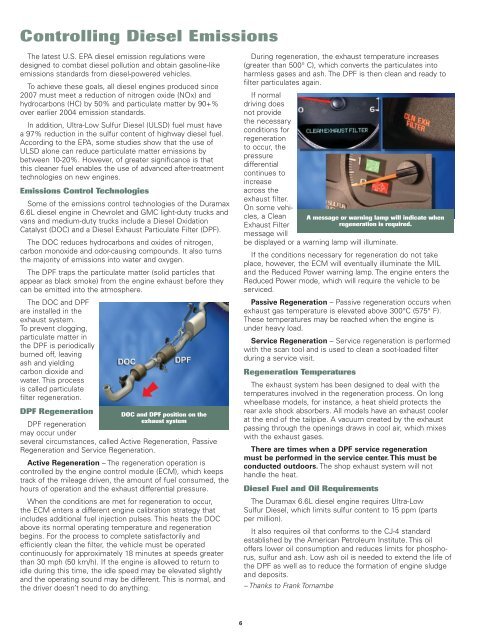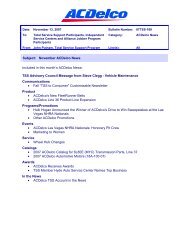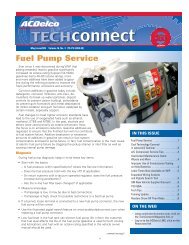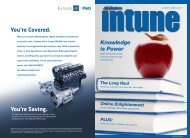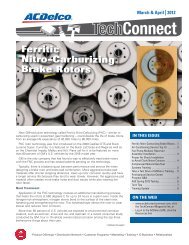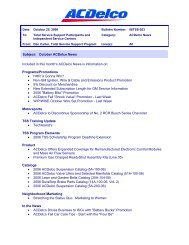Programming Tips and Tools - ACDelco TechConnect
Programming Tips and Tools - ACDelco TechConnect
Programming Tips and Tools - ACDelco TechConnect
You also want an ePaper? Increase the reach of your titles
YUMPU automatically turns print PDFs into web optimized ePapers that Google loves.
Controlling Diesel Emissions<br />
The latest U.S. EPA diesel emission regulations were<br />
designed to combat diesel pollution <strong>and</strong> obtain gasoline-like<br />
emissions st<strong>and</strong>ards from diesel-powered vehicles.<br />
To achieve these goals, all diesel engines produced since<br />
2007 must meet a reduction of nitrogen oxide (NOx) <strong>and</strong><br />
hydrocarbons (HC) by 50% <strong>and</strong> particulate matter by 90+%<br />
over earlier 2004 emission st<strong>and</strong>ards.<br />
In addition, Ultra-Low Sulfur Diesel (ULSD) fuel must have<br />
a 97% reduction in the sulfur content of highway diesel fuel.<br />
According to the EPA, some studies show that the use of<br />
ULSD alone can reduce particulate matter emissions by<br />
between 10-20%. However, of greater significance is that<br />
this cleaner fuel enables the use of advanced after-treatment<br />
technologies on new engines.<br />
Emissions Control Technologies<br />
Some of the emissions control technologies of the Duramax<br />
6.6L diesel engine in Chevrolet <strong>and</strong> GMC light-duty trucks <strong>and</strong><br />
vans <strong>and</strong> medium-duty trucks include a Diesel Oxidation<br />
Catalyst (DOC) <strong>and</strong> a Diesel Exhaust Particulate Filter (DPF).<br />
The DOC reduces hydrocarbons <strong>and</strong> oxides of nitrogen,<br />
carbon monoxide <strong>and</strong> odor-causing compounds. It also turns<br />
the majority of emissions into water <strong>and</strong> oxygen.<br />
The DPF traps the particulate matter (solid particles that<br />
appear as black smoke) from the engine exhaust before they<br />
can be emitted into the atmosphere.<br />
The DOC <strong>and</strong> DPF<br />
are installed in the<br />
exhaust system.<br />
To prevent clogging,<br />
particulate matter in<br />
the DPF is periodically<br />
burned off, leaving<br />
ash <strong>and</strong> yielding<br />
carbon dioxide <strong>and</strong><br />
water. This process<br />
is called particulate<br />
filter regeneration.<br />
DPF Regeneration DOC <strong>and</strong> DPF position on the<br />
exhaust system<br />
DPF regeneration<br />
may occur under<br />
several circumstances, called Active Regeneration, Passive<br />
Regeneration <strong>and</strong> Service Regeneration.<br />
Active Regeneration – The regeneration operation is<br />
controlled by the engine control module (ECM), which keeps<br />
track of the mileage driven, the amount of fuel consumed, the<br />
hours of operation <strong>and</strong> the exhaust differential pressure.<br />
When the conditions are met for regeneration to occur,<br />
the ECM enters a different engine calibration strategy that<br />
includes additional fuel injection pulses. This heats the DOC<br />
above its normal operating temperature <strong>and</strong> regeneration<br />
begins. For the process to complete satisfactorily <strong>and</strong><br />
efficiently clean the filter, the vehicle must be operated<br />
continuously for approximately 18 minutes at speeds greater<br />
than 30 mph (50 km/h). If the engine is allowed to return to<br />
idle during this time, the idle speed may be elevated slightly<br />
<strong>and</strong> the operating sound may be different. This is normal, <strong>and</strong><br />
the driver doesn’t need to do anything.<br />
During regeneration, the exhaust temperature increases<br />
(greater than 500° C), which converts the particulates into<br />
harmless gases <strong>and</strong> ash. The DPF is then clean <strong>and</strong> ready to<br />
filter particulates again.<br />
If normal<br />
driving does<br />
not provide<br />
the necessary<br />
conditions for<br />
regeneration<br />
to occur, the<br />
pressure<br />
differential<br />
continues to<br />
increase<br />
across the<br />
exhaust filter.<br />
On some vehicles,<br />
a Clean A message or warning lamp will indicate when<br />
Exhaust Filter<br />
regeneration is required.<br />
message will<br />
be displayed or a warning lamp will illuminate.<br />
If the conditions necessary for regeneration do not take<br />
place, however, the ECM will eventually illuminate the MIL<br />
<strong>and</strong> the Reduced Power warning lamp. The engine enters the<br />
Reduced Power mode, which will require the vehicle to be<br />
serviced.<br />
Passive Regeneration – Passive regeneration occurs when<br />
exhaust gas temperature is elevated above 300°C (575° F).<br />
These temperatures may be reached when the engine is<br />
under heavy load.<br />
Service Regeneration – Service regeneration is performed<br />
with the scan tool <strong>and</strong> is used to clean a soot-loaded filter<br />
during a service visit.<br />
Regeneration Temperatures<br />
The exhaust system has been designed to deal with the<br />
temperatures involved in the regeneration process. On long<br />
wheelbase models, for instance, a heat shield protects the<br />
rear axle shock absorbers. All models have an exhaust cooler<br />
at the end of the tailpipe. A vacuum created by the exhaust<br />
passing through the openings draws in cool air, which mixes<br />
with the exhaust gases.<br />
There are times when a DPF service regeneration<br />
must be performed in the service center. This must be<br />
conducted outdoors. The shop exhaust system will not<br />
h<strong>and</strong>le the heat.<br />
6<br />
Diesel Fuel <strong>and</strong> Oil Requirements<br />
The Duramax 6.6L diesel engine requires Ultra-Low<br />
Sulfur Diesel, which limits sulfur content to 15 ppm (parts<br />
per million).<br />
It also requires oil that conforms to the CJ-4 st<strong>and</strong>ard<br />
established by the American Petroleum Institute. This oil<br />
offers lower oil consumption <strong>and</strong> reduces limits for phosphorus,<br />
sulfur <strong>and</strong> ash. Low ash oil is needed to extend the life of<br />
the DPF as well as to reduce the formation of engine sludge<br />
<strong>and</strong> deposits.<br />
– Thanks to Frank Tornambe


